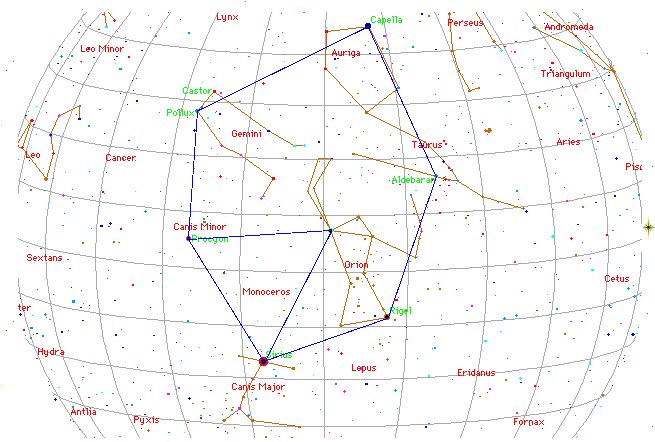116. The point of the southern horn of Taurus has been named The Heavenly Gate and its Greek letter was chosen as ζ.
Above the Heavenly Gate was the point of the northern horn (Elnath, the Butting One, β Tauri) at the bottom of Auriga. And below the Heavenly Gate was the Club of Orion, in front of which was the outstretched left foot of Castor. Tejat Prior (η Gemini) was down in the Milky Way and so was the Club of Orion.
Betelgeuze, on the other hand, was at the other side of the Milky Way compared to Tejat Prior - viz. at the armpit of Orion. We can see from the shape of Orion in the overview map of the constellations above that it could be perceived as an armpit drum: ... The most important of all drums, he said, was the armpit drum. The Nummo made it. It consists of two hemispherical wooden cups connected through their centres by a slender cylinder. It is like an hour-glass with a very long narrow neck. With this instrument tucked between his left arm and armpit, the drummer, by pressing on the hollow structure of thin wood, can tighten or relax the tension on the skins and so modify the tone. 'The Nummo made it. He made a picture of it with his fingers, as children do today in games with string.' Holding his hands apart, he passed a thread ten times round each of the four fingers, but not the thumb. He thus had forty loops on each hand, making eighty threads in all, which, he pointed out, was also the number of teeth of his jaws. The palms of his hands represented the skins of the drum, and thus to play on the drum was, symbolically, to play on the hands of the Nummo. But what do they represent? Cupping his two hands behind his ears, Ogotemmêli explained that the spirit had no external ears but only auditory holes. 'His hands serve for ears,' he said; 'to enable him to hear he always holds them on each side of his head. To tap the drum is to tap the Nummo's palms, to tap, that is, his ears.' Holding before him the web of threads which represented a weft, the Spirit with his tongue interlaced them with a kind of endless chain made of a thin strip of copper. He coiled this in a spiral of eighty turns, and throughout the process he spoke as he had done when teaching the art of weaving. But what he said was new. It was the third Word, which he was revealing to men ... The place of creation was an armpit, it was said: ... In the beginning there was nothing but the sea, and above soared the Old-Spider. One day the Old-Spider found a giant clam, took it up, and tried to find if this object had any opening, but could find none. She tapped on it, and as it sounded hollow, she decided it was empty. By repeating a charm, she opened the two shells and slipped inside. She could see nothing, because the sun and the moon did not then exist; and then, she could not stand up because there was not enough room in the shellfish. Constantly hunting about she at last found a snail. To endow it with power she placed it under her arm, lay down and slept for three days ... Although in later days the location of the creation could have been changed:
Anciently the place of creation could have been defined from the Heavenly Gate (*84) and with Phakt far down in the south as a pointer for those with good eyes. 118 (= 4 * 29½) days later was Spica (*202 = *84 + 118) with the Fox high up in the north for those with good eyesight.
... Proclus informs us that the fox star nibbles continuously at the thong of the yoke which holds together heaven and earth; German folklore adds that when the fox succeeds, the world will come to its end. This fox star is no other than Alcor, the small star g near zeta Ursae Majoris (in India Arundati, the common wife of the Seven Rishis, alpha-eta Ursae ... The Arabs in the desert regarded it as a test of penetrating vision; and they were accustomed to oppose 'Suhel' to 'Suha' (Canopus to Alcor) as occupying respectively the highest and lowest posts in the celestial family. So that Vidit Alcor, et non lunam plenum, came to be a proverbial description of one keenly alive to trifles, but dull of apprehension for broad facts ... Allen: "Although inconspicious, Lockyer thinks that it [α Columbae, Phakt] was of importance in Egyptian temple worship, and observed from Edfū and Philae as far back as 6400 B.C.; but that it was succeeded by Sirius about 3000 B.C., as α Ursae Majoris was by γ Draconis in the north.
And he has found three temples at Medinet Habu,
adjacent to each other, yet differently oriented,
approximately towards α, 2525, 1250, and 900 years
before our era: all these to the god Amen. He thinks
that as many as twelve different temples were
oriented to this star; but the selection of so faint
[sic!] an object for so important a purpose would
seem doubtful."
|
||||||||||||||||||||||||||||||||||||||||||||||||||||||||||||||||||||||||||||||||||||||||||||||||||||||||||||||||||||||||||||||||||||||||||||













